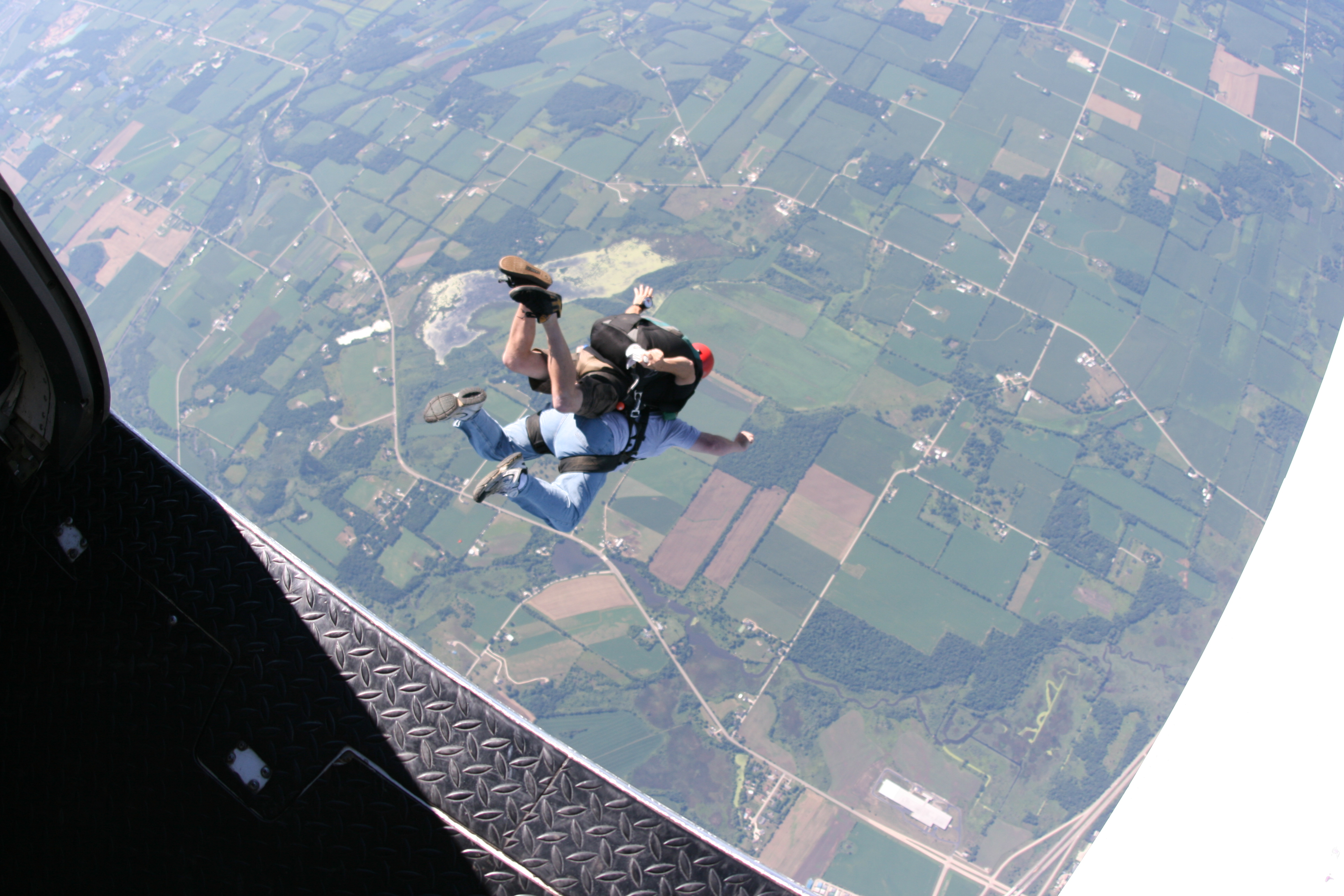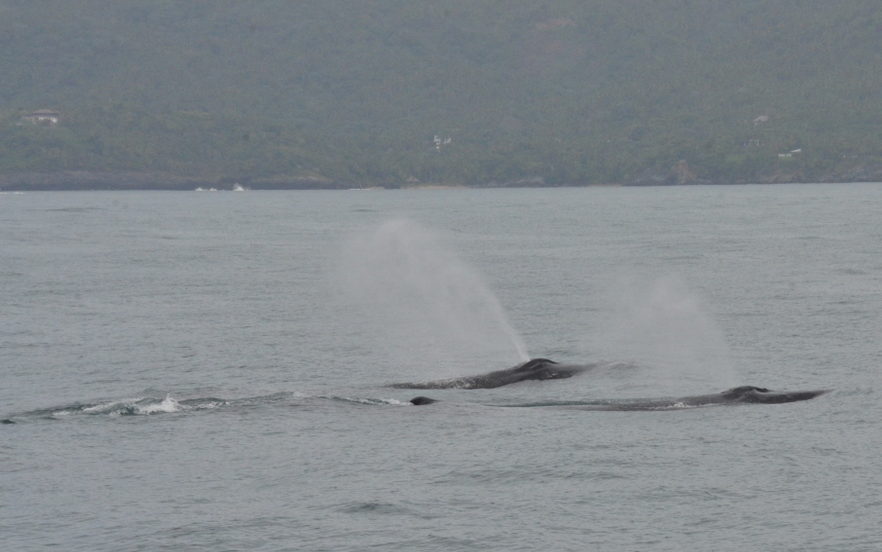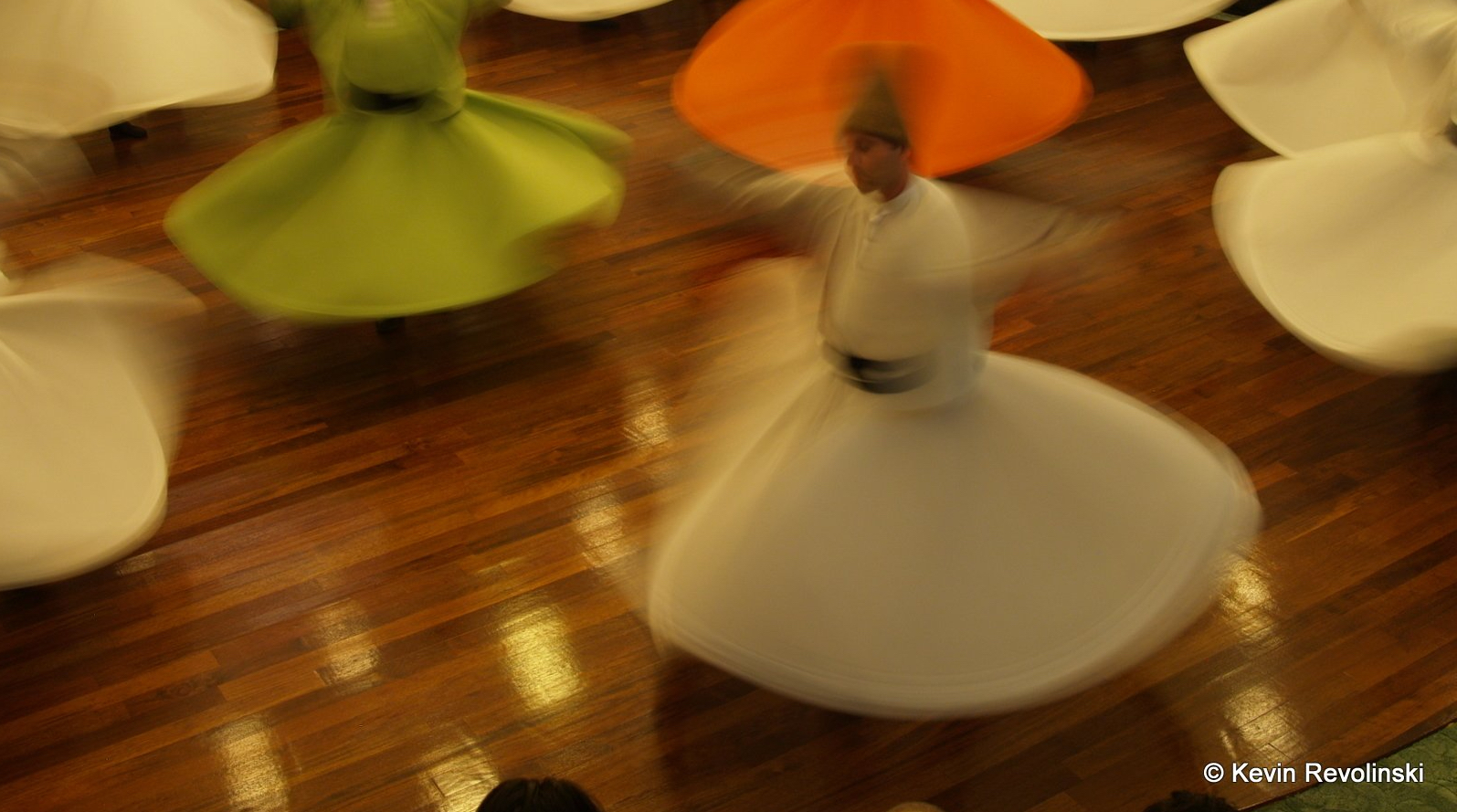Click for audio on this topic from a WUWM broadcast below:
Friday night, 7:30 p.m.: It’s time for my young son to go to bed, and we’re lying together and looking at the map app on my iPhone.
“There we are,” I say, pointing to the blinking dot in the middle of the grid as the GPS shows us our current location, a tiny blue ripple lost in the patchwork puzzle of Southeastern Wisconsin.
He stares, fascinated. “I want to go there,” he whispers.
“But we are there,” I tell him, “That little blinking dot is us.”
“No,” he insists, “I want to go in there,” and taps the screen to make sure I understand.
Saturday morning, 9:30 a.m.: it’s time for my first skydive, and I am standing at the open door of a small light plane approximately 13,500 feet above the ground, my toes over the edge of the threshold and my heart beating a mile a minute. Again, I see Southeastern Wisconsin laid out before me, so small that it seems like I could hold it in the palm of my hand. I’m about to follow my young son’s impulse, and fall into the map.
Traveling@Home
How far away do you have to go before it becomes travel? Around the world? Across the country? Out of state?
How about 40 minutes away?
The heart and soul of travel really has nothing to do with distance, and more to do with exploration. It’s all about seeing the world from a different perspective. Many people journey to distant lands and never leave their insulating protective layer of concierges, tour groups and manufactured experiences. Journeying to strange places is a quick and easy hit to shake up your consciousness, but in the end, no matter where you go, it’s contingent upon you to actually, well, make the leap.

Sky Knights of East Troy
It is with this thought that I find myself one bright summer Saturday morning in East Troy, Wisconsin, a quick drive from downtown Milwaukee, preparing to face my fear and jump out of a perfectly good airplane. Skydive Milwaukee is home to the Sky Knights Sport Parachute Club, and they operate a drop zone there, and have for nearly half a century.
The Sky Knights are an interesting breed. While they are all individuals, I told my wife that they seemed like an unlikely combination of surfer and Navy Seal. The smart, sunny Sky Knights I met that day all seemed to be passionate enthusiasts for their sport, and have a whiff of that zen attitude that is particular to surfers. In sharp contrast to any surfer I’ve ever met, however, they were ferociously disciplined about their sport. I sat in on a class for novice skydivers who were aspiring to do solo jumps, and the instructor drilled them for more than an hour on the simple act of pulling the ripcord. Over and over they drilled. Still their instructor was not satisfied. They were still drilling when I left to do my first jump.
What to Expect
First of all, you don’t have to really do any training if you want to keep things simple and be able to concentrate on enjoying your experience. This means opting for a tandem jump, which means your back is tightly strapped to the chest of your instructor. This looks awkward, and it is when you are trying to walk through the plane together, but once in the air, you can almost forget that your instructor is there.
You will sign a long, excruciatingly detailed form — it’s almost funny — that harrowingly details every bad thing that could conceivably happen to you if you skydive. This part is all about liability, but read it anyway. If you have any imagination at all, none of it will come as a surprise to you. You’ll also watch a video, which further impresses upon you that you are going to jump out of a plane. And all the while, from the time you arrive to the moment before you leap, your instructor is telling you everything you need to know, explaining every step of what you are about to do.
One of the comforting things I learned is that it doesn’t much matter what you do. As long as you’re basically cooperative there’s not much the passenger can do to screw things up. The instructors are in the position to control the whole skydive, and have a ton of experience doing it all safely. If you don’t pull your ripcord when you’re supposed to, your tandem partner is going to do it for you. Period.
I don a one-piece suit and protective eyewear. I walk to a small, light plane resting on the green expanse of lawn and climb aboard. A few moments later, we’re in the air.

Arguing with the Animal
During the ascent I have been having a quiet but intense chat with the Animal part of my brain, which, until this moment, had settled for clearing its throat significantly, and coughing and saying “asshole!” at the same time to me. The Analytical part of my brain tamps him down.
Seven thousand feet.
But as the time to jump approaches, the Animal is getting noticeably more animated, volunteering to take over, and suggesting with ever-greater urgency many creative ways to get out of doing this in favor of some relaxing, ground-based entertainments. With some effort, I manage to ignore the Animal.
Thirteen thousand feet.
But the higher we climb, that harder that is to do. I’ve wanted to do this all my life, but — truth be told — I’ve become scared in my old age. I keep reminding myself that some of the most transforming experiences in life lie on the other side of fear. Yet while I still want very much to experience this, I am having to push myself through the fear to get there.
Thirteen-and-a-half thousand feet.
It’s time. My instructor has told me we will count to three and then jump. We creep together toward the door until my toes are over the edge, my arms crossed over my chest — I can’t help but think— like a corpse on display in a casket. At the very moment when I would most want some tiny level of control over my own body, I surrender all of it.
“ONE!” my instructor says and leans perilously through the door, pushing me ahead of him.
“WHOA!” says the Animal part of my brain, “We talked about counting to three before we jumped but nobody said ANYTHING about leaning out into the abyss to physically emphasize each number! I get it, okay!? I can count without leaning, alright?! Man! That was a close one! I sure hope he doesn’t do that aga–”
“TWO!” says my instructor, leaning forward even farther. For an instant, more of my body is outside the plane than in.
“He did it again!” the Animal gibbers, “But it’s okay because we’re STILL IN THE PLANE. There is still plenty of time to rethink this whole thing—“
“THREE!” and this time my instructor leans like he means it and suddenly we are in launched into thin air.

A millisecond later, ten feet below the bottom of the plane, we flip and I am looking straight up at the bottom of the tiny craft.
“Still time to go back!” the Animal part of my brain yells before it faints completely. Thank God. That guy was getting on my nerves.
Everything to See
Once the Animal part of my brain has mercifully fallen silent, an amazing calm comes over me. I’ve been told in advance that talking is impossible during the free-fall portion of the dive, and I am suddenly grateful for it. There’s nothing to say. But there is everything to see.
Falling from 13,500 feet, I think of my son’s words again. The immensity of the world is humbling from up here. The rest of my day, of my week, of my precious schedule, is dwarfed into insignificance by what I’m doing. It’s me, and this guy I met an hour ago, and the Earth’s atmosphere. That’s all. And it’s breathtaking.
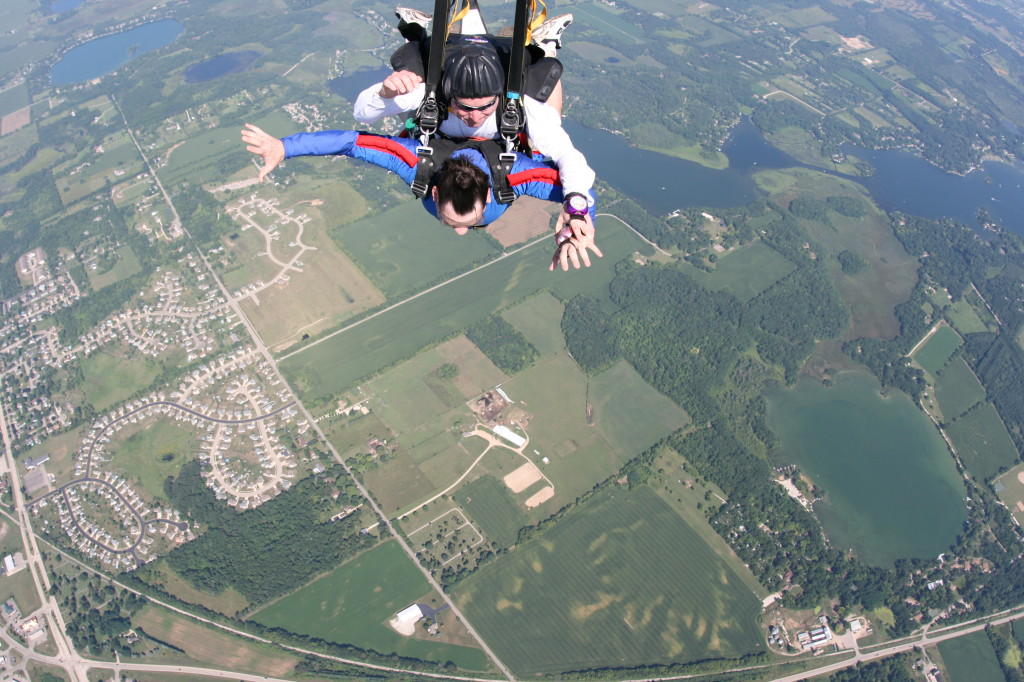
My instructor wakes me out of my reverie as he grabs my wrist and shows it to me. The gizmo on my wrist shows that we’ve reached 5,000 feet, and it’s time to deploy my chute. Crap. I had one job and I blew it. But it doesn’t matter; he’s got my back. I reach back with his hand guiding me, and pull the cord, and abruptly the speed changes and suddenly we’re floating on nylon.
Now the wind abates and we can talk easily. My conversational abilities have degenerated at this point to repeating the word “Wow!” over and over again, but he doesn’t seem to mind. He tells me what I’m seeing and points out geographical features that help me orient myself. He shows me things that I might not have recognized on my own. Lakes. Towns. Places that I think I know. But they are all wonderfully new to me from this fresh perspective.
“Robert, pull hard on the right hand strap, let’s move you around a bit,” says my instructor, so I obligingly tug on the strap, in what seems to me like a considered, responsible adult fashion, and sure enough, we start to slowly turn in that direction.
“No, no, let’s put something into it,” he says, and grabs my hand and pulls way, WAY down on the strap and the chute responds by immediately going into a tight spin. Suddenly I am looking right at the parachute, which has miraculously appeared right in front of me. It occurs to me that I liked it better where it was, above me, holding me aloft, slowing my descent — y’know, that sort of thing. The Animal part of my brain starts to talk in its sleep. But it’s fine. My instructor is in total control of this thing, of the two of us, and he’s giving me the nickel tour.
As we draw closer to the ground, the map slowly begins to resolve itself into individual details. Then even finer-detailed objects swim into focus and the sense of acceleration increases, though we are still drifting down at the same speed.
I’m positively giddy, and it’s all fun at this point. Hell, even the Animal part of my brain is enjoying itself.
We drift closer and closer and he tells me to stick out my feet and get ready to take a few steps forward when we touch down to the ground. The land rushes up at us and I do as I’m told. Suddenly, I’m walking forward quickly on the grass. My instructor deftly unsnaps the straps that bind us together and it’s over.
I haven’t felt so alive in a long, long time.
And I really, really want to do it again.
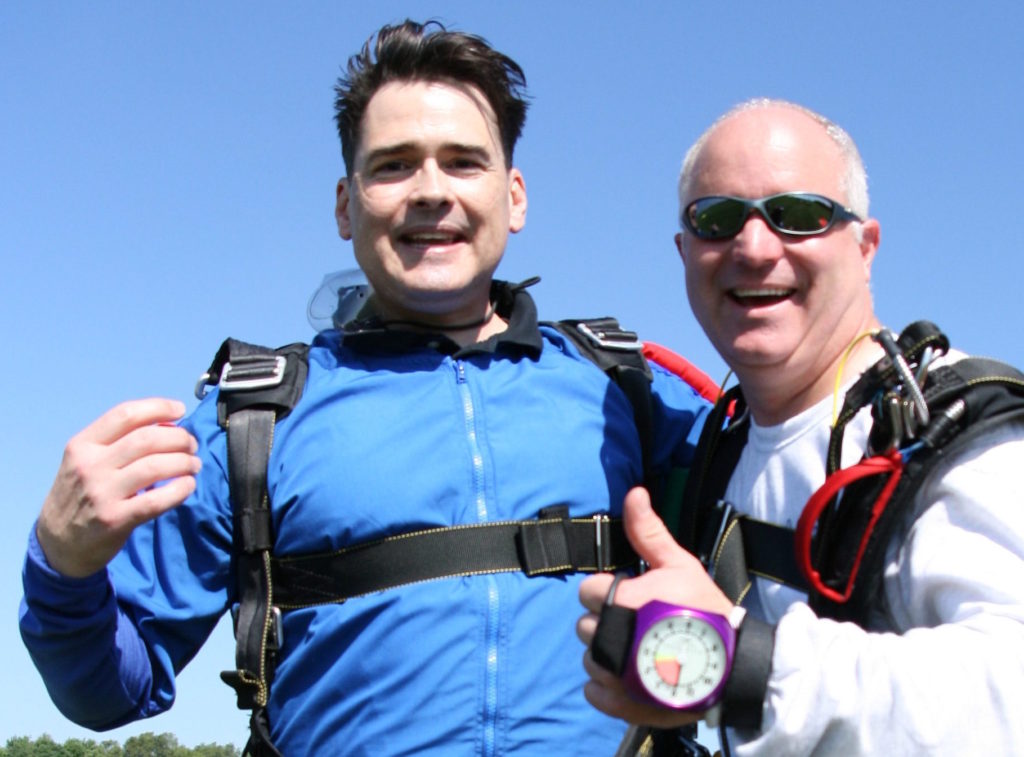
When You Go
A first tandem jump is $189.
Sky Knights is located at: W1341 Hwy L, East Troy, WI, 53120
Group rates range from $139-$179 per person.

